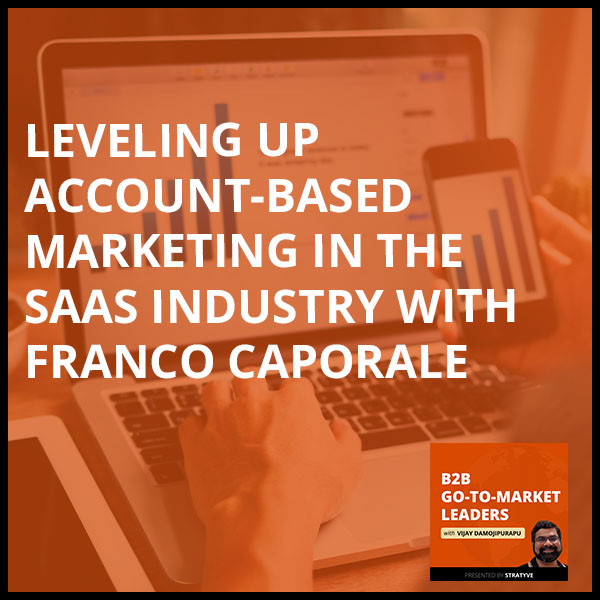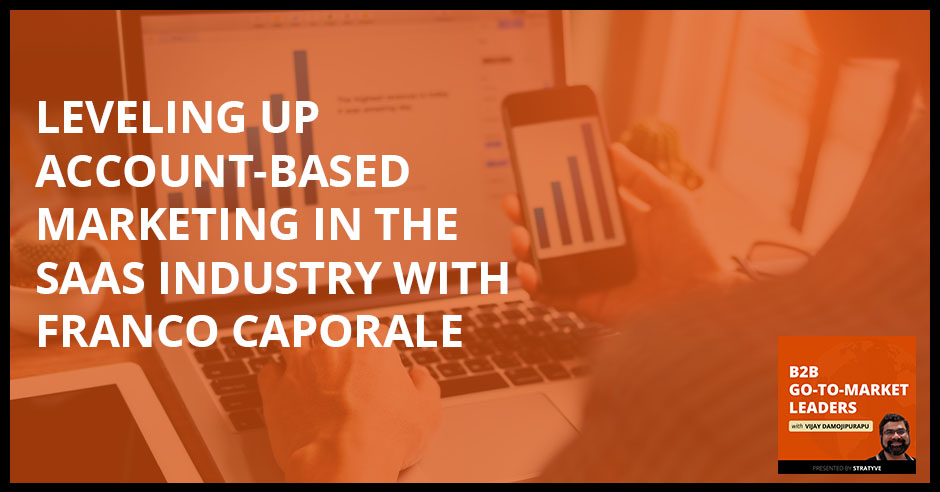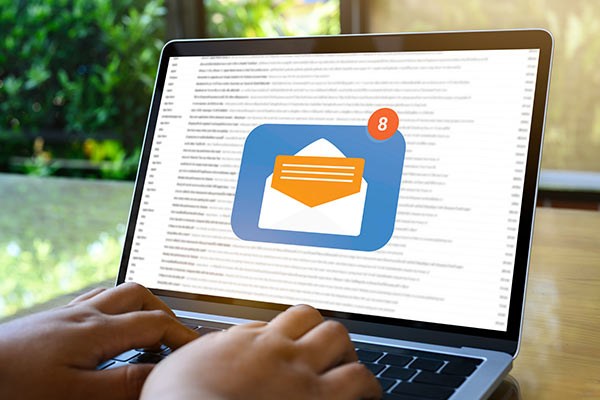

In today’s internet-driven world, the influence and non-stop growth of the Software-as-a-Service or SaaS industry cannot be set aside. For Franco Caporale, this online environment is the best way to make it big in account-based marketing. Vijay Damojipurapu sits down with the CEO and Founder of SaaSMQL to talk about how he began his journey in the realm of ABM. Franco discusses the most effective strategies to approach potential clients, the differences between ABM and B2B marketing, his experiences in coping with remote setup, and the best way to increase business revenue. He also shares a bit about himself, from his family, the people who served as his inspiration, to what his parents think about his career.
—
Listen to the podcast here
Leveling Up Account-Based Marketing In The SaaS Industry With Franco Caporale
I have the pleasure of speaking with Franco Caporale. He is the Founder of SaaSMQL. I won’t share too many details now. I will get into those details downstream, but one nugget for the readers here is I typically have a policy where I don’t host agencies in general on my show, but then I got on a call with Franco. I’m glad that we got on a call and I got to know you more at a personal level. I’m glad that we’re doing this show. For the readers, it’s about how Franco’s company SaaSMQL is helping, shifting, and elevating the whole ABM game in the SaaS industry. That would be cool for all the readers. Let me not keep you waiting any further. Franco, welcome, and I’m excited to have you on the show.
Thank you. I’m excited too.
Where are you based out of?
I’m based in Redwood City in the Peninsula of the San Francisco Bay Area.
I always start the show and ask this question to my guests, which is the show is all about go-to-market. My question to you is how do you define and view a good market?
I’ve always been focused on B2B. To me, the go-to-market is all the processes and steps that a company needs to implement in order to engage, convert and retain their customers. The go-to-market spans from every activity that you perform in sales and presales, the entire sales process, the onboarding process, and all the customer success activities that are necessary for a customer to be successful and that generates the growth of the company once that motion is implemented correctly.

One element that I see missing, and I want to get your thoughts is where does the product fit in this all go-to-market in your mind?
We can expand the two products as well. For many companies, when you talk go-to-market, you assume that the product has been not done, but it is in a state that can be sold, then you have to incorporate the product as a feedback loop once you start working with your customer to implement a new feature and get product expansion and development that is necessary to retain those customers because I worked primarily with SaaS companies where most of the profits are generating for customers stay for a long time, usually 2, 3 or 5 years. The product now is the product that’s going to retain those customers for longer. In my world, the product is a little bit more on the side, but I’m sure product professionals will disagree on that, but I’m very focused on the sales and marketing aspect.
When I was doing a podcast with another guest of mine, it struck me. I’m going to be off this too. Even though I include chronic, marketing, sales, and customer success in this entire go-to-market spectrum, but there’s also one other key element, which is the user experience. The user experience is a huge part of this overall go-to-market, especially if your product and if your company is product-led. That is a good reminder for me as well.
Any companies I work with, we do interface with the product but there’s a longer-term collaboration where you try to influence their roadmap from feedback that you receive from prospects and customers. When you are in the trends in the go-to-market, you work with what you have and try to align your solution with the long-term needs of the customers. There is a limit on the influence that you can have from marketing or sales.
A longer-term collaboration can be achieved by influencing people’s roadmap from the feedback you receive from prospects and customers. Share on XWhy don’t you share your overall journey, not as to what you do now and what your company does now, but what led you to this path?
I don’t want to go back too far, but I’m originally from Italy. I’ve been in California for fifteen years. My whole career I spent in B2B marketing and primarily on cloud software and SaaS companies. I was in the demand generation space for over ten years working at Couchbase, Duetto, all the venture-funded companies here in the Bay Area, San Francisco, then I went to a YC company called Apptimize. In my last full-time role, I was head of enterprise marketing at Branch.io, which is a company that has tremendous growth, was founded a few years ago and raised over $300 million. Now it’s a unicorn company. When I joined, we were 90 people. After that, I decided to start my own company because I always wanted to have my own business and drive everything. I decided to start as a consulting company initially, my company is called SaaSMQL. I focus on SaaS and marketing. I always say, if someone doesn’t know what SaaS or MQL is, it’s not a good potential customer for us.
You have your own filtering tracker right here.
Every time I hear, “What is MQL?” I was like, “Never mind.” It started as a consulting for demand generation for SaaS, but realized that it was not a scalable model. Even better, I realized that the most important thing that we were doing with our clients was all related to account-based marketing. That’s what was moving the needle when we look at all the different activities that we were helping implementing all the marketing operations side, all the different campaigns, webinars, nurturing. Everything that was ABM specific was driving 90% of the dashboard of results that we were showing. We decided to focus on account-based marketing, develop a framework which is what I’ve been using since Duetto, Branch, and all my full-time roles, and build that framework that drives the results for our clients.
We standardize this approach and make it more scalable. We develop infrastructure processes, automation to help companies implement this account-based marketing strategy and scale it. It has shown to be scalable quickly. I’m an old marketing operation person at heart. My career started as a Marketo professional. I was being hired to manage the Marketo Architecture and implementation and drive this lead flow. Initially, as an inbound marketer then I started working more and more with enterprise companies as a target. The reason why I started switching to ABM is because of the frustration of when you run this massive inbound marketing campaign, but you know your target is very narrow, so you can wait and hope that some of your targets come along and download a white paper for a webinar. I started looking at ways to target a specific set of companies without investing money outside of it. That’s what shifted my career to account-based marketing.

You mentioned and highlighted a couple of good points over there. You mentioned about how you started off in a very marketing operations role. Over time you saw that the efficiency came when you started targeting specific companies. Some people call and even I refer to them as like, maybe it’s the dream 50 or the dream 100 clients.
We like to segment the accounts having tier 1, tier 2, tier 3. The main reason why I started focusing was for example, at Duetto, we were targeting hotel and hotel chains, but we had integration, restriction, or requirements. If they weren’t using a certain technology, they were not a good fit. They might have been a good hotel chain and great potential customers but we couldn’t sell to them. We were disqualifying way too many leads after the initial sales conversation. We knew what companies were using specific technology that we integrated with. That’s when it became necessary to start focusing. At Branch, for example, we were targeting the top 200 apps in the app store. Those are a well-defined side of companies. Inbound marketing is great because it scales and drives a lot of volumes but you need a mix of both in most companies in order to generate real growth. You want to have the inbound motion, but also focus your budget on the companies that you know will be a good fit.
One of the notions that is playing on my mind now and which I’m noodling with is what I refer to as the outbound to drive inbound.
We see that as well when we work with our clients. We started running these campaigns that are very specific and then all the other lead sources started going up, we start seeing more people filling out the form and they’re all pre-qualified. We see more traffic is exactly right, but all of these different channels play together, you need great content to run good account-based marketing campaigns. You need to have a good funnel on the sales side. You have to have ways to qualify leads, to run discovery calls, to nurture them because most of these companies are not ready to buy when you engage. If you engage them when they’re ready to buy, you’re probably too late.
If you engage with companies when they are ready to buy, you are probably too late. Share on XThat’s what I keep telling my clients when they said, “How do we find companies that they have a project already and they are looking to buy a solution?” I’m like, “That’s way too late if you’re engaging at the moment that they already have a shortlist of companies that probably have been influencing their decision for many months.” You need to start when they are not looking and their response is going to be, “We’re not looking right now. Thank you.” That’s the first touch and that is a long process. It’s a marathon.
You hit upon another big point, which is very dear to my heart, which is content. Content is key. No matter what you do within marketing, even if it’s branding or if you’re doing outbound, or if you’re doing any customer marketing, it all boils down to content, and I agree with you. Content, you need to put it out there. If you are talking to someone who is actively evaluating alternators, our products, and services, which means you’re already late in the game. There’s research out there, which is 50% or even 60% of the research is already done by a buyer even before they engage with someone from the company or if it’s sales.
Especially if your competitors have been nurturing those companies for a long time, what happens? You start the sales and start approaching them when they are already looking but your competitors are being top of mind for them for many months. The chance that you can steal it from them is very low. That’s why it’s necessary to target your ideal set of accounts and start making sure you are in front of them month after month with good content, adding value, providing different type of help, making sure that they know you are a resource in case they have that type of problem and they want to solve that pain.
For me, since I have a bit of an engineer or a product development DNA within me, the way I look at, and this is something that came to my mind and I would like to hear your thoughts as well on this, is I see an analogy. Content is to marketing similar to what codebase is to developers.

You need that fuel to drive any kind of campaign, both in account-based marketing and inbound marketing. In my career, I use content in an efficient way. At Duetto, we were doing these webinars with thousands of people and it was purely educational. The Duetto is a revenue management platform. We were doing this webinar about basically the best practice for revenue management and the actual courses. We develop like a full course of five hours. That was turned into an actual course by Coursera. They reach out to us and say, “We love that content,” but it was educational. Someone early in their career could take the class and learn best practices. Someone more advanced, director, VPs could also learn a lot. That became a source of leads and they started recognizing a lot of companies and the solution that is behind that great content. That’s how we drove most of our pipeline.
Let’s switch gears here on the lighter and fun note. Do you have kids?
My wife and I have a dog. We adopted him from Taiwan. There are a few organizations that saved dogs in Taiwan because they get killed there and they send them to the US. I encourage everyone who is looking for a dog, take a look at this organization. The one we worked with was Love and Second Chances. These dogs are amazing. I spend a lot of my days walking my dog. They adopt. They save thousands of dogs from being killed in Taiwan and Korea.
I’m going to pivot my question over here, which is how your parents would describe what you do?
My parents will say that I have companies that make more money. That’s I think how I was able to explain it to them. My father said, “I don’t understand what you do.”
As long as you make money and you help companies make money, that’s good.
We help them sell more so that they would understand. Even my friends who are not in this space have a hard time understanding how the process of B2B demand generation works and how the scalable funnels and flows that we implement work and how the process is.
You need the initial, successful customer to know that you have a good product-market fit. Share on X“In my company, we help other companies make revenue.” You mentioned about ABM and the role of ABM that helped you pivot and grow your career both as an employee, as well as a founder. Let’s double click on the concept of ABM. ABM at a high level is Account-Based Marketing, but if you double click and something that I’ve seen and spoken with other marketing leaders, CMOs, and VPs of marketing, and they agree broadly, which is ABM if you boil it down, it’s marketing 101.
Some people say ABM equal B2B marketing, not necessarily for me. ABM is my equal enterprise marketing. I do think that even compares that targets enterprise only like Fortune 500 or Fortune 1000, you can say, “I’m only doing ABM.” I still vouch for the value of creating a good inbound marketing flow where you’re not targeting a specific set of companies per se. You are targeting more on the intent, you are driving that awareness that is going to help even companies like Box, for example, purely enterprise play, but they have a great inbound flow that has helped moving up market. In the beginning, they were not serving enterprise. In fact, it’s hard for the company to start by selling enterprise. You don’t have the capabilities to do it, but the inbound combined with ABM becomes powerful. There are people that think that ABM means selecting ten companies and creating a whole different experience for them like a new website or all the content is super personalized.
You can do it that way if it works for you if you’re targeting IBM and Google as your potential customers. To me, ABM is saying, “I want to focus my marketing budget on a specific set of accounts. I start from the account first and then I develop my program versus the opposite, which is inbound marketing. I start from the content, then the intent first, and we’ll see who comes across.” It doesn’t have to be like that level of hyper-personalization. You can do it on a small set of accounts, but if that’s all you’re doing, either you have a ton of budget that you can dedicate resources to the accounts, or you’re not going to have the traction that you will have when you segment the multiple tiers and create different level of personalization and focus on that.
You shouldn’t personalize for each account. You should have different tiers. I’m not too much into the names or the trends that say, “What is account-based marketing?” In the past, the same thing would’ve probably called vertical marketing or industry marketing. There are many different names. With every client, we start by saying, “Who should we target in the next six months, or this year? Who is the ideal customer profile? Who have you closed that we want to find more of? What do these companies look like and what signals do they have? Can we build a list that all accounts that match that profile and then go after them actively?”
Let’s double click on that for the benefit of our readers. Why don’t you share a case study of the raise that you’ve delivered for one of your clients that you are proud of? That shifted, not your bottom line and top line, but how it shifted the company’s revenue growth.
We have many case studies. I can’t mention the names, but I’ll talk as much as possible. We have worked with a company called Intellimize since, before the raise of Series A and we love that company. I recommend it to everyone. It’s a great product. It’s related to scale the testing of your website and understanding there’s not AB testing because they do it with a lot of AI. It’s a much better way to do AB testing and they work with large companies as well as startups, but it’s a great phenomenal company and product, and we’ll be working with them for two years.

I want to put a disclaimer over here for the readers, this is not paid or any sponsorship.
I’m passionate about the company. The reason for that is we work with them. In the first nine months of working together, we generate something over $5 million in the pipeline by focusing on a specific list of accounts, which were 800 accounts and our program is very high touch. Meaning, we combine different channel like emails, LinkedIn ads, Facebook ads, display ads, as well as direct mail to engage that specific list of accounts. What we see is, there are channels that are great to drive that initial engagement, and then there are channels that are great at generating that conversion, which for us conversion is a discovery call booked. What we found is direct mail is phenomenal at generating that conversion. You need to find a way to scale that, but first, you need to create that initial engagement because you don’t want to start with direct mail as the first start per se.
We create these funnels where we combine these different channels, all targeting the same list of companies, and that’s what we do for every client. In Intellimize, we have a case study published on our site where we talk on how we generate over $5 million in the pipeline in nine months. We have other clients, one of which I won’t mention the name. Since August 2020, they have closed $1.7 million in revenue from our program. We have generated over $12 million in the pipeline that is still $6 million open.
This program can be effective once you start targeting and you are very strategic in selecting the accounts that you target. If your list is too big and you try to target 5,000 companies with a $20,000 budget, it’s the same when trying to boil the ocean with a match. You can’t do that. Unless you have a ton of budget, the focus should be narrow. That’s why dream 100 as well as tier 2 and tier 3, but with a specific budget allocated. One of our clients got successful exit. Alphonso, one of our clients, got acquired by LG where they made a majority investment. It was a great success for the company and we’ve been working with them since 2019.
It boils down to the basics and what you mentioned. You should not try boiling the ocean. You would rather touch ten accounts and touch it to 5 or 10 times versus trying to touch 100 accounts once.
Start a business while you are young so you will have a lot of time to make mistakes and thrive. Share on XWhen the clients ask us why we have 500 companies, why not 1,000. “All these other companies could be a good fit.” I’m like, “Yes, they could be a good fit, but each company that you target comes at a cost.” We usually determine what their cost per target account is. It can be $50 or $100 or $200 in the timeframe because, in each account that you’re targeting, you need to have a certain number of an impression on LinkedIn and Facebook or every display ads. You need to potentially send a few direct mail gift boxes, maybe 3 or 4 to different people. All of this comes out with a cost. If you have a small budget, what happens is most of your accounts are going to have 1 or 2 touches or maybe 0. Maybe they see your ad once or maybe zero times.
Instead, what you are looking to do is surround your target companies and your target prospect with your brand, messaging, marketing touches to the point that like, we had a call from the discovery column of one of our clients who the senior person at Fortune 500 companies said, “I never heard of your company before. All of a sudden, I start to see you everywhere on LinkedIn. A week later, I received a box from you and I knew I had to speak with you and learn more.” That’s exactly what we’re trying to do here.
It’s a good combination of healthy awareness on getting on someone’s radar and then creating curiosity.
Also, drive that call to action. At some point, you have to go once they have developed a level of engagement, you need to help them make the next step and incentivize them to want to learn more. The messaging is important. The channel they use is important and we use direct mail for the simple reason that it separates us from everything else and everyone else, because most of the companies nowadays are not doing it. Why are they not doing it? Because it takes a lot of work, a lot of moving parts. It’s way easier to launch a LinkedIn campaign or launch an email campaign. You can do that in half an hour. Direct mail requires a lot of work and budget. In my whole career, two vendors send me a box and at the same time, I got millions of emails. What do you think I remember the most? I still remember those two vendors now. That’s the power of choosing the right channels.
When I was the head of marketing at Green Bits, it’s a Series A company a couple of years ago. I did receive a lot of phone messages as well as email messages, but one thing that stood out and I still remember to this day is a physical mail sent by someone at Marketo.
It was Demandbase. The one that I remember the most.
It’s simple. Nothing fancy. All they did was a normal envelope. It was like candy or cakes or I don’t know what it was, but I still remember it was that mail and with the candy and saying, “Why don’t we get on a call?” Something along those lines.
In my past career, when we were targeting the head of product, we target Amazon. It was a senior person in the main app of Amazon. We send them a box and he was excited that the next meeting, he invited all these colleagues and he said, “I never received anything from any vendor.” That’s how it can separate you. You can do direct mail. We don’t want to start going down. The important thing is creating that multichannel flow sequence where you are engaging them not in one channel. I see too many companies doing LinkedIn ads only or email. That doesn’t work in the long-term.
Now that many people are working remotely, how did you shift and evolve your direct mail campaigns?
It was tricky at the beginning, especially in March and April 2020. We were like, “What’s going to happen now?” Nobody knew. It became easier every month that passed. We implemented additional steps on the campaign to confirm their address before we ship and say, “I understand you might be working remotely. Should we send it somewhere else? Do you have another address?” We don’t usually like to specifically ask their home address because that’s too aggressive in my view, but we do ask for an alternative address. Now, it’s easy. About half of the people that are in the office at least 2 or 3 days a week. The other half gave us their home address if they are still remote. They vary state by state.

It’s something that we had to navigate at the beginning. We used to ship the box, no problem. We knew that they will reach them. We still have to play a little safer, but we ship now thousands of boxes every month on behalf of our clients. We have seen tremendous results in the past few months. If companies are holding on, they’re making a mistake, but it’s better for us if they’re not bombarding people with direct mail.
All these personal touches add up in your marketing. Shifting gears a bit over here. I think you are working with the earliest stage startups like either seed or Series A or Series B?
Our ideal customers are usually Series B or Series A, they have usually 40 to 50 to 100 employees and they have a strong product-market fit. They have good customers but they’re looking to go from $2 million or $3 million or $4 million in recurring revenue to $10 million or $20 million. That’s our typical ideal customer. We also have some clients that are in the earliest stage, they’re bootstrapped or seed funded and trying to get to the Series A level, or they’re trying to grow revenue. We then have some larger clients that are 300 employees, but they are looking for helping driving this account-based marketing program while they focus on other segments or other initiatives. We run the ABM program for them. We work very closely with our clients. We do weekly calls and monthly strategy reviews. We’re full services and so we drive every single implementation. One example of these larger companies is Quid.com. TravelBank is also higher eCommerce. They have over 200 employees.
What would you say is the minimum ARR that you would advise before someone embarks or starts an ABM campaign?
More than the ARR, I will advise, have a few good customers with the same use case that are happy and successful. One of my main mentors, I follow his content for the past years is Jason Lemkin from SaaStr. I follow everything from SaaStr and he says it right, “If you have 2 or 3 good customers, you can have 10. If you have 10, you can have 50.” You need the initial successful customer to know that you have a good product-market fit, then you have maybe a good case study, then at the account-based marketing, becomes selling those case studies. Selling that if I could do it for them, I can do it for you because they’re very similar companies. That’s how you start scaling because you need to have the ability to invest in customer acquisition.
You need to be comfortable knowing that you have to spend to drive customers. A lot of early-stage companies always tell me, “All my customers so far came for free because of referral, because of a network.” They should have come for free, but that’s not how you scale. The only company that can scale are those that figure out paid acquisition because paid is what you can scale. Referral like in your network, does it scale? You can all of a sudden dabble or increase it by 3X. When you do pay, if I spend $10,000 and I get 3 customers, if I spend 20, I might get 6, and then maybe it doesn’t scale as linearly, but that’s what you’re trying to do. That’s why I want them to be comfortable. They should know their CAC and know that they need to invest to drive customers.
You also mentioned and highlighted something, which I want to push you on, based on your interactions with your clients, if they had extra 5 or even 6-figure budget, what are they telling you? Where would they invest that in?
They usually ask us this question because that’s what we’re there to help is we have a goal in mind, which is revenue, a number of logos close, or a number of opportunities or pipelines. We worked backward and say, “If you’re trying to drive this much revenue next year, you need this many customers, which means you need these many opportunities.” We then look, “What are your top lead sources? Where did they come from?” From our perspective, we know what channels can work. You don’t know in the first few weeks. We started running different types of sequences. What I do recommend is to invest in channels that can reach those specific companies that you have selected.
To understand when you have this extra budget in one allocation, it is always important to look where your great customer came from first. I look at all the lead sources, all the different channels, and programs that were put in place to see, “Where should we put more money?” When we start running our program and we focused on those specific channels that are capable of engaging the right accounts, we look, for example, and say like, “We can scale more direct mail. We can scale more LinkedIn ads and we try different things.” We shift the budget every few weeks depending on how it’s converting. You need to understand the full level of attribution and knowing that even if the customer convert on the direct mail, for example, it’s likely that the first task was something else.
Maybe it was an email or LinkedIn ads or Facebook retargeting or Facebook targeting or retargeting or display the ad. You can’t do then put all your money into one basket. You have to start increasing your budget linearly and in the same ratio for each channel because you are at risk of impacting your whole program when all of a sudden you started doing that. I remember in Couchbase, we were doing these webinars that were fantastic at converting opportunities. At some point, people start saying, “Why don’t we do webinars?” All of those people that joined the webinars entered our database from other sources.
If I were to stop the other sources and those first start programs, everything will have collapsed. We always look at our multichannel sequence as a whole program. The budget needs to be placed strategically that way. At the same time, I always recommend my clients, “Don’t abandon your inbound strategy. Continue writing great content, invest in content, invest in SEO, maybe also in PPC and AdWords when it’s necessary, but look at your whole campaign sequences as a program and don’t focus on a single channel because you are seeing conversion coming there.”
Even though you’re seeing conversions from your odd bond are even from one channel like a webinar, do not stop the other channels and invest in another channel. That’s your main message.
If you’re an eCommerce company or a single person or sometimes single touch conversion, that’s great. In B2B enterprise, multiple stakeholders, multiple channels that are necessary to engage and call the accounts. You have to create a program. You have to track that attribution every single touch and don’t risk turning off a channel that was an essential part of that program.
You are an expert in ABM and you are up to your game which means you are consciously investing your time and energy in finding out what’s working, what’s not working. You’re getting that from your client work, but besides working with your clients, how do you invest your time and stay up to date in the trends?
My main source of content is SaaStr. We were one of the SaaStr sponsors in 2020, that conference that didn’t happen because of the pandemic. We will be sponsoring the one in September 2021. Hopefully, it is going to be a live event, but I’ve been a big fan of SaaStr. That’s one of the reasons why I started focusing on SaaS when I started my own business is because I loved everything related to SaaS and SaaStr, and Jason Lemkin’s organization helped with this. I always listened to their podcast. I read their content, I’m on the newsletter and I attend every event that they host. For the first time, we will be sponsoring the next one, which is exciting. I always listen to audiobooks because I walk my dog for two hours a day.
The best thing to do is listen to audiobooks on Audible. I have a ton of books to recommend. I tend to read all of that old books related to either business or sales. One of my last books was New Sales. Simplified by Mike Weinberg. It’s a great book. I strongly recommended it. Also, another one is The Ultimate Sales Machine. I like books about entrepreneurship like E-Myth, which is one of my favorite and Traction. I like stories of entrepreneurs and startups. One of my favorites is Shoe Dog, which is the story of Nike. It’s extremely entertaining, a lot of good lessons, and strongly recommended.
A big shout-out to Jason Lemkin and what the team is doing at SaaStr. I’m a big follower of Jason Lemkin’s insights and wisdom. I do listen to the podcast, and the newsletter, and all the LinkedIn publications. That’s advice to all the readers. If you’re looking to up your game broadly in sales, you got all the great resources that Franco mentioned over here. Thank you for that.
Great books are strongly recommended.
As we head towards wrapping up this episode, I’ll ask a couple of questions for you. One is, can you name 1 or 2 or 3 people who have influenced you and shaped your career? Who would those be?
One was my strategy professor during my MBA at Pepperdine. That was my last class. That professor changed a lot in the way I approach problems and it was an extremely impactful class for me. My father has always been an entrepreneur. He was always against me finding a job somewhere. He always wanted me to have my own business. He never worked for anyone his entire life. That’s another one.
We see where you’re getting all your drive and passion from.
For entrepreneurship, yes. Both my parents were super supportive when I moved to the US from Italy. My whole journey in the US has been particular. I worked for five years at a university in the patent office. The office where we file a patent for technologies and I had to meet with even a Nobel prize, like Walter Kohn. I went to his office and he was describing his new technology and new research. I got to meet the extremely bright researchers. That whole experience is the reason why I’m in the US and have shaped everything that I’ve done after.
The final question to you is if you were to go back in time and imagine it’s your first day in your go-to-market career and journey, what would your advice be to that younger self?
First of all, I wish I could go back to many years ago. I would have taken a different approach to many things. I would recommend not even to find a job from the beginning. If I would go back, I will start my own business at nineteen, because that gives you so much time to make mistakes and try. I read the book Rich Dad Poor Dad that everyone knows about. I’m a big believer of that philosophy of saying like, “You want to have the freedom of working for yourself because time is the most important thing. Time shouldn’t be spent doing things that you don’t like and working for someone else if you don’t love it.”
I will have tried to start my own business, try to start multiple ones, and focusing on creating something scalable that doesn’t require my time. That’s what I always have in mind because you realize when you get older that time is limited. It’s the only limited thing you have. It’s not money. It’s time, so why would you spend time doing things that you don’t like to do? This is the reason why I started my own business. This is the reason why I wouldn’t want to work full-time again for anyone. It is fun. If you are only twenty-year-old, you don’t have anything to risk, go and start a business, and learn it. You learn so much faster and you learn about everything. You have to manage your account or your finance, your operation, everything. This would be my main suggestion.
This has been a great conversation. If anyone out there wants to learn more about you, your company, and what you do, where can they find you and how can they learn more about you?
Our website is SaaSMQL.com. We also have a community called DemandGen Club. It’s on DemandGenClub.com. This is a community I started in 2016 when I was still full-time at Apptimize. I did it for passion because I like to speak about demand generation and B2B marketing. We were doing meetups in San Francisco. Those were not possible in 2020. We pivoted to have now a virtual community. We also have a podcast and webinars, but we’re hoping to resume the meetups and do it not only in San Francisco but outside of it. Sign up if you want to stay up to date with our events. We also have a meetup group as well.
Thank you, Franco. It’s been a pleasure. Wishing you, the SaaSMQL, and the whole DemandGen community a lot of best wishes. Good luck to you and your team.
Thank you, Vijay. This was fun. I enjoyed it.
Important Links
- SaaSMQL
- Branch.io
- Love and Second Chances
- Quid.com
- SaaStr
- New Sales. Simplified
- The Ultimate Sales Machine
- E-Myth
- Traction
- Shoe Dog
- Rich Dad Poor Dad
- DemandGenClub.com
Love the show? Subscribe, rate, review, and share! http://stratyve.com/
